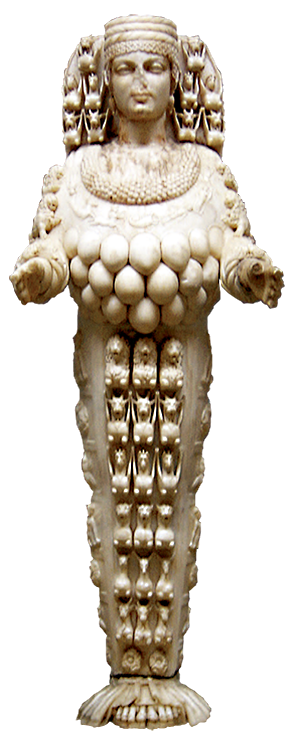
Bible, History, Archaeology
Bible,
History,
Archaeology
The apostle Paul's third journey
Contents:
Map of the third voyage – Introduction
To view the map, click on the image
Introduction
Dates vary from source to source and are approximate.

Image opposite Asian Artemis was not the Artemis or Diana of classical mythology, but the mother goddess of Asia Minor, known as Cybele, Magna Mater and Ma.
It was a deformed woman with a crowned head, innumerable breasts (according to other researchers, they were more like strings of bulls' testicles) and outstretched arms supported by props. Ephesus Archaeological Museum, Selçuk.
He writes to the Church of Rome, which he does not know, but where he plans to go (Acts 19,21), because it is the heart of the pagan world.
After celebrating Easter in Philippi, Paul joins Asia in Troas. During a long night meeting, a young man falls asleep, falls from the third floor and kills himself, but Paul brings him back to life (Acts 20,9-12).
Reading and commentary: Acts of the Apostles 20:7-10.
«On the first day of the week, we came together to break bread. Paul, who had to leave the next day, was talking with the disciples, and he prolonged his discourse until midnight. [...]. Now a young man named Eutychus, who was sitting by the window, fell into a deep sleep during Paul's long discourse; carried away by sleep, he fell from the third floor below, and was raised dead. But Paul, having come down, bent over him and took him in his arms, saying: Do not be troubled, for his soul is in him.
When did the meeting take place?
The description of this meeting begins with the words: «On the first day of the week». In the Greek version, this phrase is translated as: «the first day of the Sabbath». According to the Jewish calendar, only one evening is considered Yom Rishon (the first day): the evening after the Sabbath, Saturday night. The following evening would correspond to Yom Sheni (the second day), as Jews count the days from the previous evening.
«Escorting the Queen»
The story continues: «We were gathered together to break bread». If they gathered on Saturday evening, the «breaking of bread» took place during the third and final Sabbath meal: melave malkah, which means «escorting the queen». Jewish tradition dictates that this meal often lasts well into the night, sometimes even into the early hours of the morning.
Even today, some churches still celebrate the Eucharist on Saturday evenings. This custom comes from an ancient tradition dating back to the apostolic age. Early believers celebrated the Melave Malkah and then probably observed the end of the Sabbath with the Lord's Supper.
Paul then set sail for Jerusalem to celebrate Pentecost. At Miletus, he bids a fond farewell to the elders of the Church of Ephesus: «I know you'll never see my face again» (Acts 20,17-38). Paul was expecting serious difficulties, as his Jewish adversaries were plotting against him, but they were all-powerful in Jerusalem. The crossing ends at Ptolemais (Akko, the Crusaders' Saint-Jean-d'Acre). In Caesarea, the prophet Agabus predicts Paul's arrest (Acts 21,8-14). Despite the pleas of his friends, Paul went up to Jerusalem anyway.
Links to the apostle Paul's other journeys:
The apostle Paul's first missionary journey →

Obverse :
Silver cistophore coin (Pergamon).
Ephesus, circa 41-42.
Nude head with halo to the left.
Revers :
DIAN - EPHE
Artemis of Ephesus standing in front of her temple; on the pediment, two statues and three tables. © D.R.

